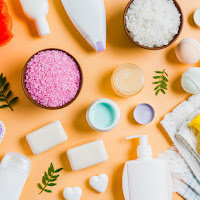Your Step-by-Step Guide to Optimal Facial Exfoliation: Prep, Cleanse, Exfoliate, and Moisturize Your Way to Perfect Skin.
Facial exfoliation helps to remove dead skin cells, unclog pores, and leave your skin looking fresh and smoother, so it should be an essential part of your skincare routine.
 |
| Best Way to Exfoliate the Face, Source: Freepik |
And to get the best results, you must choose the right way to exfoliate your face. There are different ways and tools to exfoliate the face, including chemical exfoliants, facial scrubs, and cleansing brushes.
This blog post will help you learn how to exfoliate your face in the best way.
What is exfoliation & Why Is It a Must-Have Step in Your Facial Skincare Routine?
Exfoliation is the process of removing dead skin cells from the outer layer of the skin. While our skin can shed dead cells naturally, sometimes it needs a little help to get rid of them all. And that's where exfoliation comes in, helping to slough off the remaining dead skin cells, unclog pores, and promote cell turnover.
There are two main ways to perform facial exfoliation, physical and chemical.
- Physical exfoliation uses tools, such as facial scrubs or brushes, to remove dead skin cells.
- Chemical exfoliation uses acids, such as alpha and beta hydroxy acids, to gently dissolve dead skin cells.
How to Choose the Right Facial Exfoliator for Your Skin Type:
Choosing the right facial exfoliant for your skin type is essential to achieve the best results and avoid allergic reactions or irritation. Here are some tips to help you choose the best face exfoliator for your skin type and concerns:
1. Determine your skin type: This step will help you narrow down the kind of exfoliator that will meet the needs of your facial skin: (Your guide & quiz to know your skin type for the right exfoliation products choice).
2. Consider your skin concerns: When choosing an exfoliant for your face, you must consider your skin concerns, such as acne, dryness, or sensitivity.
3. Read the ingredients: Read the ingredients list to make sure the exfoliant does not contain any ingredients that may irritate your skin or cause an allergic reaction.
5. Test the product: Always patch test before using a new exfoliant on your face. Apply a small amount of the product to your forearm and wait 24 hours to see if there is any allergic reaction or irritation.
Best way to exfoliate face: Your step-by-step guide for optimal results:
 |
| Your step-by-step guide for optimal results |
The best way to exfoliate your face involves four main steps: preparation, cleansing, exfoliation, and aftercare. Here's a bullet point guide to each step:
- Preparation:
- Start by washing it with a gentle cleanser to remove dirt, oil, and makeup.
- If you have time, try steaming your face beforehand to open up your pores. One way to do this is to place your face over a bowl of hot water and cover your head with a towel to trap the steam.
- Cleansing:
- After cleansing and steaming (if desired), rinse your face with lukewarm water to remove any remaining cleanser or steam residue.
- Exfoliating:
- Choose a facial exfoliator that is appropriate for your skin type and concerns(How to use Paula's Choice BHA Exfoliant). You can use a physical exfoliant, such as a scrub with granules, or a chemical exfoliant, such as an exfoliator containing AHAs or BHAs: (AHA skincare & BHA skincare).
- Apply a small amount of the exfoliator to your fingertips or a facial brush and gently massage it onto your face in circular motions. Be careful not to apply too much pressure.
- Pay special attention to areas that tend to be more oily or prone to breakouts, such as the T-zone.
- Follow the instructions on the exfoliator label for how long to leave the exfoliant on your face. Generally, it's best to leave it on for no more than a minute or two.
- Rinse your face thoroughly with lukewarm water to remove the exfoliator.
- Aftercare:
- After exfoliating your face, it is important to follow up with a moisturizer to keep your skin hydrated and healthy.
- If you exfoliate during the day, be sure to apply a broad-spectrum sunscreen with SPF 30 to protect your skin from sun damage.
- Don't exfoliate your face more than once or twice a week to avoid redness, irritation, and dryness.
The Top Benefits of Facial Exfoliation for Healthy Skin:
Here are the top benefits of facial exfoliation to know why exfoliating the face should be an essential part of your skincare routine.
- Unclog pores: Facial exfoliation helps to effectively unclog pores by removing dead skin cells and other surface debris that may remain on your skin after cleansing.
- Increases cell turnover & Improves skin texture: Facial exfoliation helps promote the growth of newer, healthier skin cells. This process improves skin tone, radiance, and texture, resulting in a fresher, revitalized glow and a more luminous appearance.
- Stimulates collagen synthesis: Regular exfoliation of the face helps stimulate collagen synthesis to improve skin texture and integrity and keep skin looking plump, firm, and youthful.
- Allows for better absorption of skincare products: Exfoliation removes the barrier of dead skin cells, allowing your serums, moisturizers, and treatments to absorb more effectively.







